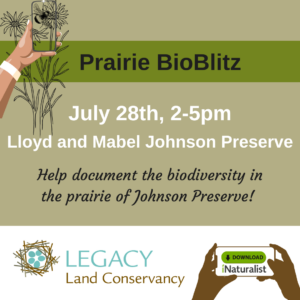By Camryn Brent, Huron Pines AmeriCorps member
Many people rely on nature as a way to get away and reset from the constant notifications of our tech-based world. That includes me. Ironically though, I almost never head out on an outdoors adventure without my smartphone!
One reason is for safety, and another reason is I use my phone as a scientific tool while I’m exploring. I put my phone on “do not disturb” and pull up the iNaturalist (iNat) app. iNat is an online community tool contributing to biodiversity science and through it, my phone has the sole purpose of documenting species observations that catch my eye. Photos of any living organism–from single celled protozoa to an American bison–can be added to iNat.
The idea around iNaturalist is as simple as it is vast; to record the biodiversity of the natural world. In the pursuit of this goal, iNat connects naturalists and shared expertise from all over the world.
I love iNat and feel lost without it when I’m in nature. Having a tool readily available to help me with identification has really helped me grow exponentially as a naturalist. Like other social media platforms such as Instagram or Facebook, iNat has become a part of me and I associate my observations with my own personal growth. Sometimes I wince when I see old observations I posted when I first began using it. Download iNaturalist How to Make an Observation Tips & Tricks.
In addition to the personal benefits of tracking my observations, each post I log contributes to community science and helps land conservancies like Legacy. Since Legacy doesn’t have the capacity to record every plant or animal species found on our preserves, they depend on the observations by the people–like me–who visit them. When visitors post their observations, they become a part of Legacy’s stewardship team!
To help grow the amount of species data connected to our preserves, we have created a Legacy Land Conservancy iNat account. Our account has collection projects setup for all seven Legacy preserves. Within each project, data collected is organized by taxa (biological classification) and quality grade. For more information on iNat and terminology, check out this FAQ.
iNat is also a great way to conduct outreach events known as BioBlitzes. As the name suggests, BioBlitzes are surveys on all the living things in a particular place and during a specific time. Unlike traditional scientific inventories, BioBlitzes completed with the assistance of tools like iNat but can be done by anyone. A group of people come together in a designated place with a goal of looking at everything around them, recording what they see, and creating a snapshot of the biotic life present.
For land conservancies BioBlitzes are super helpful gathering information that can help influence the land management decisions of a particular site. Finding unique species or capturing the bloom time or emergence of plants is invaluable data for a natural community. For individuals who participate, they gain personal knowledge on the non-human life within their communities.
 Legacy has recently begun using BioBlitzes as part of a larger preserve stewardship management plan in order to help boost awareness of the biodiversity within our natural areas. This summer, on Friday, July 28th from 2-5pm, Legacy is hosting an iNaturalist BioBlitz of the restored prairie at Lloyd and Mabel Johnson Preserve. The more people who join us, the more data we will collect. If you are interested in participating, click here to see details about the event.
Legacy has recently begun using BioBlitzes as part of a larger preserve stewardship management plan in order to help boost awareness of the biodiversity within our natural areas. This summer, on Friday, July 28th from 2-5pm, Legacy is hosting an iNaturalist BioBlitz of the restored prairie at Lloyd and Mabel Johnson Preserve. The more people who join us, the more data we will collect. If you are interested in participating, click here to see details about the event.
As a Huron Pines AmeriCorps member, I am only a temporary part of the Legacy stewardship team. However, the iNaturalist observations I have made on Legacy’s preserves during my service will be a part of them forever.
Obviously, people can connect with nature and observe it closely without using social media, but sharing my findings motivates me. With all the uncertainty I feel as an environmentalist, capturing photos and posting them in a pool of data can be incredibly cathartic. Even though technology and smartphones can be distracting, making observations on iNat causes me to stop and focus on the smaller components of my surroundings. Whether studying the angles of a plant or watching a bumble bee in flight, I can dial in and be fully present.
I’ve been a huge nature nerd my entire life and, yet, every day how I view the natural world changes the more I learn. And I’ve got iNaturalist to thank for a lot of that!
Check out Legacy’s iNaturalist account and join me at the Johnson Preserve prairie later this month for Legacy’s first BioBlitz. Click here for details.
PS – If you don’t think iNat is right for you, there is another program called Seek. The Seek app still allows you to identify species with a point of a camera, but it does not require you to post an observation in order to do so. This may be a good option for beginners, those not yet old enough to be on a social media platform, or anyone wary of sharing data.


 RSS Feed
RSS Feed